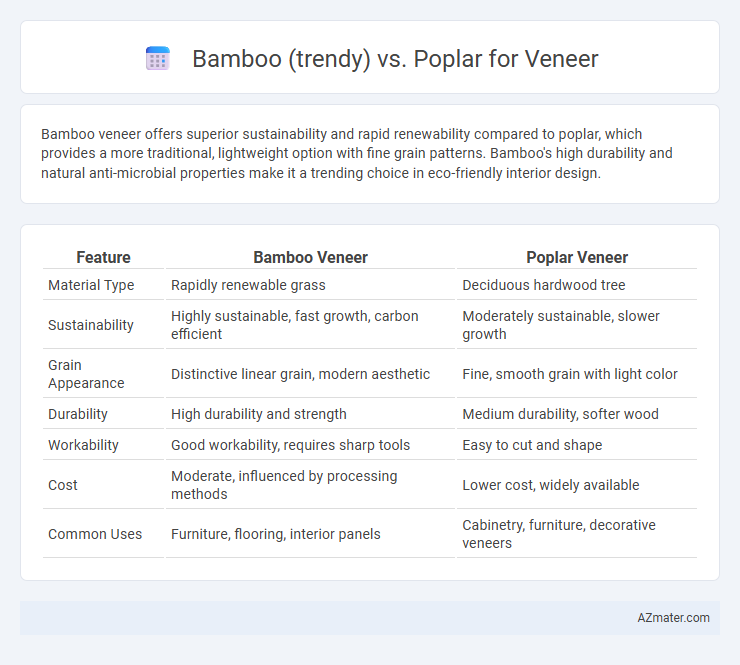Bamboo veneer offers superior sustainability and rapid renewability compared to poplar, which provides a more traditional, lightweight option with fine grain patterns. Bamboo's high durability and natural anti-microbial properties make it a trending choice in eco-friendly interior design.
Table of Comparison
| Feature | Bamboo Veneer | Poplar Veneer |
|---|---|---|
| Material Type | Rapidly renewable grass | Deciduous hardwood tree |
| Sustainability | Highly sustainable, fast growth, carbon efficient | Moderately sustainable, slower growth |
| Grain Appearance | Distinctive linear grain, modern aesthetic | Fine, smooth grain with light color |
| Durability | High durability and strength | Medium durability, softer wood |
| Workability | Good workability, requires sharp tools | Easy to cut and shape |
| Cost | Moderate, influenced by processing methods | Lower cost, widely available |
| Common Uses | Furniture, flooring, interior panels | Cabinetry, furniture, decorative veneers |
Introduction to Veneer Trends: Bamboo vs Poplar
Bamboo veneer gains popularity in modern interior design for its sustainability, durability, and distinctive grain patterns, making it a preferred choice for eco-conscious projects. Poplar veneer offers a smoother texture and consistent light color, ideal for customizable finishes and traditional aesthetics. The ongoing trend highlights bamboo's fast growth and environmental benefits contrasting with poplar's versatility and availability in woodworking.
Material Origins: Sourcing Bamboo and Poplar
Bamboo veneer is sourced from rapidly renewable bamboo culms primarily grown in Asia, especially China, where sustainable harvesting ensures minimal environmental impact through the plant's fast growth cycle. Poplar veneer originates from poplar trees native to North America and Europe, harvested from managed forests that promote responsible timber production and biodiversity preservation. Both materials emphasize eco-friendly sourcing, but bamboo's grass-based structure offers a quicker regeneration rate compared to the hardwood poplar.
Physical Characteristics: Comparing Grain and Texture
Bamboo veneer features a distinctive linear grain with a smooth, uniform texture that enhances modern and minimalist designs, while poplar veneer presents a more varied grain pattern with subtle swirls and a fine, soft texture ideal for traditional and rustic aesthetics. Bamboo's dense fiber structure delivers a harder surface, contributing to durability and resistance to dents compared to poplar's softer, more porous wood fibers, which are easier to manipulate but less wear-resistant. The natural color variations in poplar range from pale greenish to light brown, offering versatile finishing options, whereas bamboo usually maintains a consistent light golden hue that emphasizes its eco-friendly appeal.
Sustainability and Environmental Impact
Bamboo veneer outperforms poplar in sustainability due to its rapid growth rate and renewable harvesting cycle, which can be as short as three to five years compared to poplar's 10 to 15 years. Bamboo's carbon sequestration capacity is significantly higher, making it an eco-friendly option for reducing carbon footprints in furniture manufacturing. Poplar veneers, while biodegradable and sourced from renewable forests, often require longer growth periods and can be associated with greater deforestation risks if not managed sustainably.
Durability and Strength Comparison
Bamboo veneer offers exceptional durability due to its high tensile strength and rapid growth, making it a sustainable choice with excellent resistance to wear and impact. Poplar veneer, while softer and less dense, provides moderate strength suitable for lighter applications but tends to show wear over time faster than bamboo. Comparing both, bamboo outperforms poplar in both durability and structural integrity, making it ideal for high-traffic or heavy-use surfaces.
Aesthetic Appeal in Modern Design
Bamboo veneer offers a sleek, linear grain pattern and a warm golden hue that complements minimalist and contemporary interiors, enhancing natural aesthetics with sustainability appeal. Poplar veneer provides a subtle, fine texture and light creamy color ideal for versatile finishes, allowing for easy staining to match diverse modern palettes. The choice between bamboo and poplar veneers hinges on the desired aesthetic impact--bamboo's bold, eco-friendly look versus poplar's adaptability and smooth surface for customized design.
Ease of Processing and Workability
Bamboo veneer offers superior ease of processing due to its consistent grain structure and high density, allowing for smooth cuts and minimal splintering during fabrication. Poplar veneer, while softer and easier to machine, is prone to tear-out and requires careful handling to avoid surface damage, making it less forgiving in precision applications. Overall, bamboo provides enhanced workability for durable, high-quality finishes, whereas poplar is favored for projects prioritizing affordability and lighter machining demands.
Cost and Market Availability
Bamboo veneer offers a cost-effective alternative to traditional wood veneers, benefiting from rapid growth rates that ensure steady market availability and lower prices compared to poplar. Poplar veneer, while slightly more expensive, provides consistent quality and wide commercial distribution due to its long-established presence in the timber industry. The choice between bamboo and poplar veneers depends largely on budget constraints and the need for sustainable sourcing, with bamboo leading in affordability and eco-friendliness.
Popular Applications in Interior Design
Bamboo veneer is favored in interior design for its sustainable qualities, durability, and distinctive linear grain, making it ideal for modern furniture, wall panels, and flooring. Poplar veneer offers a smooth surface and uniform texture, commonly used for cabinetry, decorative molding, and painted finishes due to its versatility and cost-effectiveness. Both materials support eco-friendly design trends, but bamboo's rapid renewability gives it a stronger appeal in contemporary sustainable interiors.
Future Outlook: Bamboo and Poplar in Veneer Trends
Bamboo veneer is gaining momentum due to its rapid growth cycle, sustainability, and increasing demand in eco-friendly architecture and furniture design. Poplar veneer remains popular for its uniform texture and cost-effectiveness, but may face competition as bamboo's durability and environmental benefits become more valued. Future trends suggest bamboo will see expanded use in high-end and green construction markets, while poplar maintains a steady presence in traditional applications.

Infographic: Bamboo (trend) vs Poplar for Veneer
 azmater.com
azmater.com